Chips (crisps) packaging is a critical step in delivering fresh, crunchy snacks to consumers worldwide. Proper packaging protects potato chips, banana or plantain chips, and other snacks from moisture, light, oxygen, and physical damage – factors that can quickly make chips stale or broken. In a competitive snack market, high-quality, eye-catching bags and containers help products stand out on the shelf while keeping contents fresh for months. An effective chips packaging line uses multi-layer barrier films, precision filling equipment, and sealing machines to lock in flavor and crunch. This guide covers the key materials, processes, and machines used in modern chips packaging, from flexible pillow pouches to nitrogen-flushed canisters. It also highlights emerging trends like compostable films for sustainable packaging.
Why Packaging Matters for Chips
Packaging is not just a container – it is an active part of preserving snack quality. A well-designed chips package stops oxygen, moisture, and light from reaching the chips, which can cause them to go stale or rancid. For example, a sealed bag of potato chips often contains an inert gas (usually nitrogen) instead of ordinary air. This nitrogen cushion prevents oxidation and even gently buffers the chips against shocks during transport. The packaging also keeps chips from crushing under weight and provides a barrier against grease. In short, strong barrier materials and tight seals keep chips “crispy, safe, and visually compelling” for consumers.
At the same time, packaging serves a marketing role. Bright, printable films and labels help a brand stand out in the snack aisle. Flexible pouches and stand-up bags can be printed with vivid graphics; rigid canisters or cartons can be embossed or given tamper-evident seals. Packaging conveys flavor, brand, and quality cues to shoppers. By combining a fresh product with attractive packaging, snack makers maintain consumer trust and reduce waste.
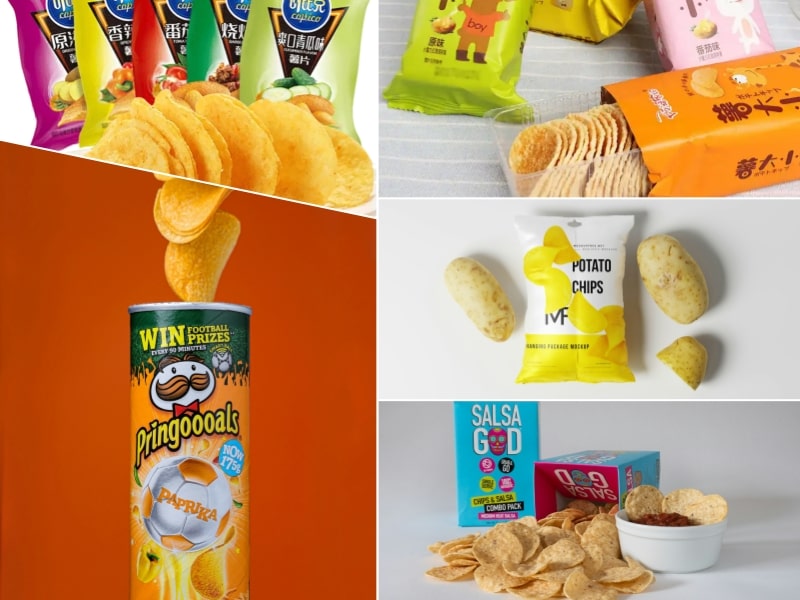
Common Chips Packaging Formats
Snack manufacturers package chips in several common formats to balance cost, convenience, and protection:
- Flexible bags and pouches: The most common format is a multi-layer plastic bag (often pillow packs or stand-up pouches). These bags are made by sealing flexible films together, sometimes with a gusseted bottom for stability. They use layers of plastic and metalized film to seal in freshness. Both potato and banana or plantain chips are often packed this way.
- Composite cans and canisters: For thick chips or premium products, rigid round containers with snap-on lids are used (similar to “Pringles” cans). These use laminated paperboard sides, a foil or plastic liner inside, and a peel-off top seal to keep chips fresh and uncrushed.
- Folding cartons/variety packs: Cardboard boxes hold multiple single-serving chip bags. These cartons (like a party mix box) keep individual pouches organized and often have die-cut windows to show the product.
- Resealable bags and tubs: Some high-end or bulk chips come in zip-lock plastic bags or plastic tubs with lids. These allow consumers to reclamp the package after opening. They require specialized filling and sealing equipment, but add convenience.
Each format has trade-offs: flexible bags are lightweight and cheap to ship, while cans and tubs offer extra strength. For instance, a sturdy canister prevents chips from breaking on the shelf. Yet flexible films can be printed in full color and laminated with a metal foil to make a very effective moisture/oxygen barrier. (The shiny inside of many chip bags is actually an aluminum coating that blocks light and air.)
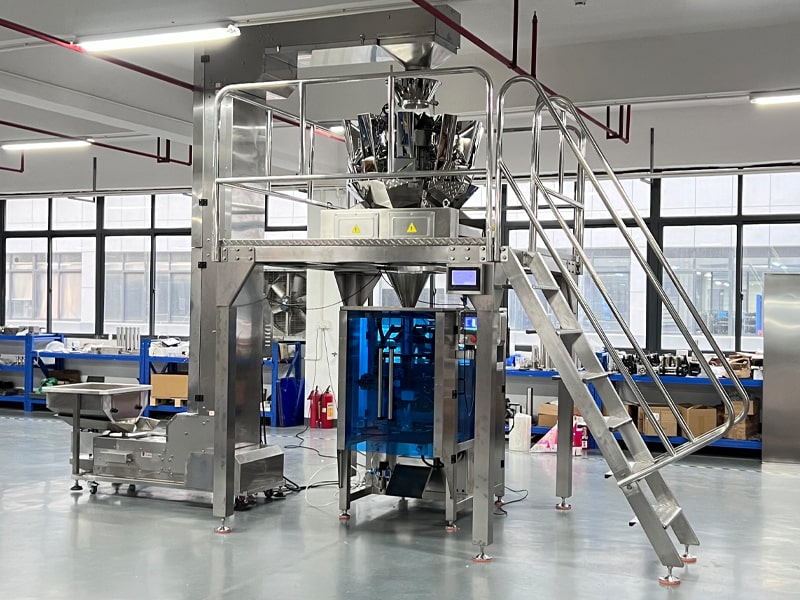
Figure: Modern chips packaging line with multihead weigher and VFFS machine for a snack factory
Packaging Materials and Structure
Chips packaging almost always uses multi-layer laminated films engineered for barrier protection. A typical bag may include:
- Metalized film (or aluminum foil): A thin metal layer that blocks light and oxygen. Often an aluminum coating is vacuum-deposited on plastic (called “metallized film”). This shiny barrier is critical to preserve flavor.
- Polyethylene (PE) or Polypropylene (PP): Food-safe plastics form the innermost layer that contacts the chips. PE or PP seals ensure oil and grease cannot leak through the bag.
- BOPP (Biaxially Oriented Polypropylene): A stiffer plastic layer (sometimes used as an outer or middle layer) that adds puncture resistance and handles printing well.
- Polyester (PET): A strong outer layer often used for high-quality printing of logos and graphics.
- Adhesive Tie-Layers: Invisible layers that bond these disparate materials together without delaminating.
By fusing these layers, manufacturers get a bag that is both strong and flexible. For example, a potato chip pouch might sandwich a metallized PET-CPP film between plastic liners to lock out moisture and air. This multi-layer film can extend shelf life dramatically. In fact, an opened bag with only nitrogen inside (no oxygen) will stay crisply fresh for months. (Note: because of the metal layer, chip bags should never be microwaved.)
Table containers (canisters) use different materials: a stiff paperboard cylinder forms the body, lined with foil or plastic inside. The lid (often plastic or metal) snaps on securely. This gives a premium, crush-proof package ideal for certain brands.
Environmental note: Traditional multi-layer films are difficult to recycle because the layers are fused. Most chip bags are not accepted in curbside recycling. This has led to new developments. For example, TIPA (a packaging innovator) recently launched a home-compostable metallized film just for snacks. This material offers a 2‑ply compostable solution with excellent oil and moisture barrier, meaning chips can stay fresh while the package breaks down in compost. Such innovations aim to reduce the large waste stream from chips packaging.
The Chips Packaging Process (Step by Step)
A modern chips packaging line automates these steps at high speed. While exact setups vary, the typical flow is:
- Bulk Conveying & Weighing: Large batches of fried chips are dumped into a hopper and fed to a multi-head weigher via conveyors and vibratory feeders. Multi-head weighers (with 10–24 heads) rapidly combine small chip portions to reach an exact target weight. A computer calculates which hopper combination is closest to the desired weight, then drops those chips into the packaging flow. This ensures each bag has the correct weight with minimal giveaway.
- Film Unwinding & Bag Forming: Meanwhile, a roll of printed laminated film (PET/CPP with metalized layer, for example) is mounted on the vertical form-fill-seal (VFFS) machine. The film is pulled around a forming tube and heat-sealed lengthwise to create a continuous vertical tube of plastic. This collar shaping produces a seam on the back of each future bag. The longitudinal seal sets the bag’s sides before any chips are added.
- Product Filling: Once the bottom of the tube is sealed, a portion of chips from the weigher is released into the open bag mouth. A vibrating funnel or chute guides the chips smoothly into the newly formed bag, preventing jams and excessive breakage. Because production is continuous, this filling happens very quickly – often dozens of bags per minute.
- Top Sealing & Cutting: After the chips enter the bag, synchronized horizontal jaws clamp and heat-seal across the top of the bag. This creates an airtight seam that locks in crispness. Immediately after sealing, a knife (or heat cutter) slices the film between bags, freeing one filled and sealed chips pouch from the film roll. The line then advances, and the bottom of the next bag is sealed to begin the cycle again.
- Alternative: Pre-made Pouch Filling (if used): Some operations use pre-formed pouches or “bags” instead of forming them on the fly. In this case, a stack or magazine of empty bags feeds a pick-and-place device. Each bag is opened by the machine, filled with chips, then moved to a top-seal station. This method accommodates specialty pouch styles (like zipper pouches or Doypacks) without changing the base machine.
- Coding, Inspection, and Packing: Every bag then passes under an inkjet or thermal printer that adds batch codes and expiration dates. Following that, automated checkweighers verify the filled weight of each bag. Many lines also include metal detectors or X-ray scanners to catch any unwanted contaminants before boxes are made. Finally, machine operators or robots arrange the finished bags into cartons or trays for boxing and shipment.
These steps happen within seconds, and are repeated thousands of times per hour. The equipment is designed for speed and hygiene: food-contact parts are stainless steel, and the design minimizes crevices where chips or oil could accumulate. Buyers of packaging lines evaluate them by throughput (bags/hour), bag size range, and ease of cleaning.
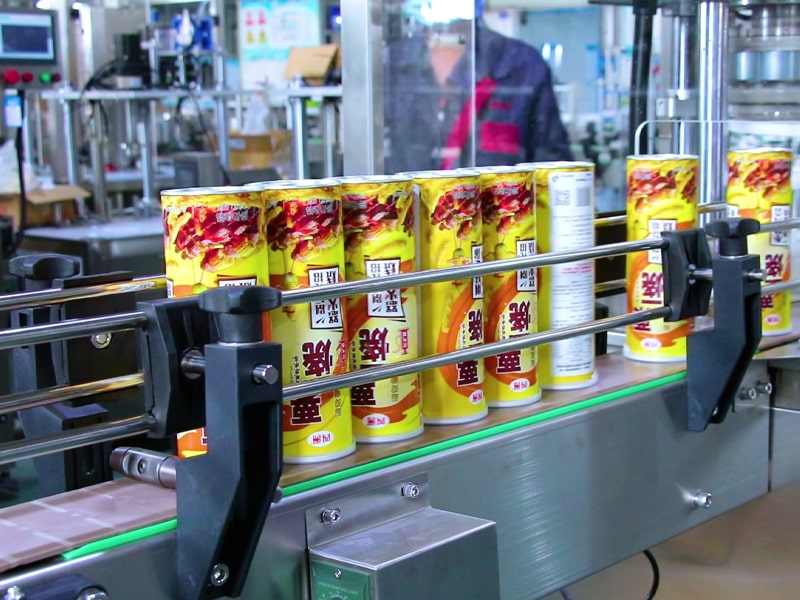
Key Packaging Machines for Chips
Several specialized machines work together in a chips packaging line:
- Multi-Head Weighers: These are vital for snacks. By weighing chips in many small loads simultaneously, they achieve extremely accurate portioning. According to industry experts, modern multi-head weighers perform “thousands of calculations per second” to ensure every bag is within tight tolerances. In practice, a combination of hoppers opens in milliseconds to deliver the exact target weight with minimal giveaway.
- Vertical Form-Fill-Seal (VFFS) Machines: This is the core “bagger” unit. Vertical FFS machines form bags from roll film, fill them, and seal them continuously. Many chip factories use high-speed VFFS systems with servo controls. These machines can make pillow-style bags or even gusseted stand-up pouches (by folding the film) on the fly. A good VFFS system handles film indexing, forming, and sealing precisely at very high speeds.
- Pre-made Pouch Fillers: If using zipper pouches or printed bags, manufacturers use a separate pouch filling machine. The machine picks an empty pouch, opens it, fills the chips, and then seals it (often by top sealing) in one cycle. These machines allow more flexible packaging formats but generally run slower than forming machines.
- Heat Sealers and Cutters: Though built into FFS machines, heat-sealing bars and cutting blades can also be standalone. In smaller lines or manual packaging, a simple band sealer or vacuum sealer might be used. But in high-speed chips lines, the sealing jaws on the VFFS do the sealing and cutting in one operation. The precise control of temperature and pressure is essential to make consistent, leak-proof seals.
- Checkweighers and Metal Detectors: After packaging, every chip bag typically goes over a checkweigher. This device weighs each sealed bag and rejects any that are underweight. Many lines also include a metal detector or X-ray unit to catch foreign metal or dense contaminants. These quality-control machines ensure compliance with food safety standards before the product is boxed.
- Packaging Line Accessories: Additional machines include conveyors, bag stackers, and case erectors. For banana or plantain chips, packaging lines are similar but may use different bag materials for acidity and moisture. Regardless, key automation elements (weighers, fillers, sealers) remain the same.
Figure: High-speed pastry packaging line (analogous to chips packaging line) with conveyors and bagging machine in a food plant.
Machine Highlight – Banana/Plantain Chips: Modern vertical packaging machines are often built to handle multiple snack products. For example, specialty banana chips packing machines have been developed with fully automated weighing, bag forming, and sealing in one compact unit. These machines offer high production efficiency and precise weighing, and can usually pack pillow bags or stand-up pouches. In fact, a banana chips line can often pack potato chips as well with minor adjustments. The same goes for plantain chips (which are similar to banana chips); lines typically use the same machinery and just adapt the seasoning and bag design. Overall, a vertical chips packaging machine can handle any bulk snack that is crispy, like peanuts, corn chips, or shrimp rolls.
Nitrogen Flushing and Freshness Control
A distinguishing feature of chips packaging is nitrogen flushing. Shortly before sealing, most chip bags are filled with nitrogen gas instead of air. This inert gas serves two purposes: it pushes out oxygen (which causes oxidation and staleness) and it creates a gentle cushion inside the bag. In fact, the reason chip bags appear puffed up (“filled with air”) is precisely this nitrogen. According to packaging experts, “the air inside potato chip bags isn’t just empty space—it’s nitrogen gas! Manufacturers use nitrogen to cushion the chips and prevent them from breaking during transport. It also keeps the chips fresh by reducing oxidation”.
Replacing oxygen with nitrogen significantly extends shelf life. A nitrogen-flushed bag can stay good for many months without added preservatives. The packaging process incorporates this step automatically: a nozzle injects food-grade nitrogen into the open bag before final sealing. In lines for potato chips and banana chips alike, nitrogen flush is standard practice. (Some highly automated can-filling lines also apply nitrogen flush just before the metal lid is applied.)
Besides nitrogen, controlling humidity is also crucial. Chips packaging lines often include in-line moisture analyzers or periodically test bag seals for leaks. Keeping the package dry prevents sogginess. Overall, oxygen and moisture levels are monitored to ensure the chips remain crisp.
Quality Control and Inspection
After sealing, each bag is inspected and coded. First, inkjet printers mark expiration dates, lot numbers, or QR codes on the bag. Then the bags pass through checkweighers to verify the weight is correct. Bags that are underweight or overweight are automatically rejected. Many lines include metal detectors or even X-ray scanners at this stage to detect any foreign material. The goal is to ensure food safety and consistency.
Some lines also perform seal integrity tests: a burst tester or visual scanner can check that every seam is fully sealed. Periodic leak tests ensure that no pinholes exist. Finally, operators collect random samples for visual inspection of print quality and bag appearance. Only after passing these checks does the machine or a worker load the bags into cartons. By the time the boxed products leave the factory, each unit has been weighed, sealed, coded, and scanned for contaminants.
Trends and Innovations in Chips Packaging
With growing environmental awareness, the chips packaging industry is exploring sustainability. As one analysis notes, “chips packaging making up a significant portion of non-recycled waste” has spurred new solutions. For instance, companies now offer ultra-thin, home-compostable barrier films specifically for snacks. These films combine compostable plastics with metallized coatings to give high barrier performance while still being biodegradable. Paired with paper or cellulose layers, such materials can deliver freshness comparable to conventional laminated films. The development of a “thin, high-performance sustainable alternative” means that snack brands may soon offer truly compostable chip bags.
Other innovations include recyclable mono-material bags (using only one type of plastic) and labels printed with eco-friendly inks. Some brands are experimenting with modified atmosphere packaging (MAP) or active freshness liners that neutralize moisture. Machine vendors are also focusing on energy-efficient designs and minimizing waste at high speeds.
Meanwhile, on the machinery side, automation continues to advance. Smart packaging lines now feature touchscreen controls, servo-driven film transport for quick bag size changes, and easy-changeover systems to handle multiple SKU runs. Integration of the entire production line (from frying and seasoning to packaging) is another trend, with some vendors offering turnkey snack processing-to-packaging solutions. Overall, the goal is to pack more chips per hour with greater precision and less manual labor, while adapting to evolving consumer and environmental requirements.
Conclusion
In summary, chips packaging is a sophisticated blend of materials science and automated engineering. A successful snack packaging line combines multi-layer barrier films (often metalized) with precise fill and seal machinery to keep chips fresh and intact. Whether packaging potato chips in large stand-up bags or banana chips in small pillow pouches, the process follows the same basic steps: portion with a multi-head weigher, form bags, fill with product and nitrogen, then seal and inspect.
By following these carefully controlled processes, manufacturers ensure every bag of chips reaches consumers in perfect condition. The latest technologies – from high-speed VFFS machines to compostable packaging films – further enhance this goal. Ultimately, good chips packaging preserves crunch and quality while meeting modern demands for efficiency and sustainability.
Frequently Asked Questions (FAQs) on Chips Packaging
What is chips packaging and why is it important?
Chips packaging refers to the process of enclosing potato chips, banana chips, plantain chips, or similar snacks in protective materials to maintain freshness and quality. It is important because it prevents moisture, oxygen, and light from spoiling the chips, while also protecting them from breakage during transport and storage.
What materials are commonly used for chips packages?
Most chips packs use multi-layer laminates made of plastic films, metallized PET or aluminum foil, and polyethylene. These layers work together to provide strength, barrier protection, and printability.
Why do chips bags contain nitrogen instead of air?
Nitrogen is an inert gas used to replace oxygen in chips packages. It prevents oxidation, which causes chips to become stale, and also cushions the chips, reducing breakage during shipping.
What types of chips packages are available on the market?
The most common options include pillow bags, stand-up pouches, resealable bags, composite cans, and folding cartons. Each type offers different benefits in terms of cost, strength, convenience, and brand presentation.
What is the difference between potato chips packaging and banana or plantain chips packaging?
The main difference lies in the product characteristics. Banana and plantain chips often contain more natural sugars and oil, so the packaging requires strong moisture and oxygen barriers. However, the same chips packaging machines (like VFFS or pouch fillers) can usually handle all varieties.
What machines are used in chips packaging?
Key machines include multi-head weighers, vertical form-fill-seal (VFFS) machines, chips packing machines, chips sealing machines, pouch fillers, checkweighers, and metal detectors. Together, they automate the process of forming, filling, sealing, and inspecting chips packages.
How do chips packing machines work?
Chips packing machines typically operate by forming bags from a roll of film, filling them with a pre-weighed portion of chips, and sealing the bags with heat. Some machines also inject nitrogen gas before sealing to maintain freshness.
How long can chips stay fresh in sealed packaging?
When properly nitrogen-flushed and sealed in high-barrier films, chips can remain fresh for several months. Shelf life depends on the packaging material, sealing quality, and storage conditions.
Are chips packages recyclable or eco-friendly?
Traditional chips bags made of multi-layer films are difficult to recycle. However, new innovations such as mono-material recyclable films and compostable chips packaging solutions are being developed to reduce environmental impact.
What are the main challenges in chips packaging?
The key challenges include preventing staleness, minimizing breakage, ensuring correct portion weight, maintaining high production speeds, and meeting sustainability goals. Packaging must balance food safety, cost-effectiveness, and brand appeal.
| References: | |
| 1. | Packaging design for potato chips ——Retrieved from:ScienceDirect |
| 2. | Effect of nitrogen flushing on shelf-life of packaged potato chips ——Retrieved from:artboulevard.org |
| 3. | The impact of nitrogen gas flushing on the stability of seasonings: volatile compounds and sensory perception of cheese & onion seasoned potato crisps ——Retrieved from:National Library of Medicine |
| 4. | Sustainable and Bio-Based Food Packaging: A Review ——Retrieved from:National Library of Medicine |


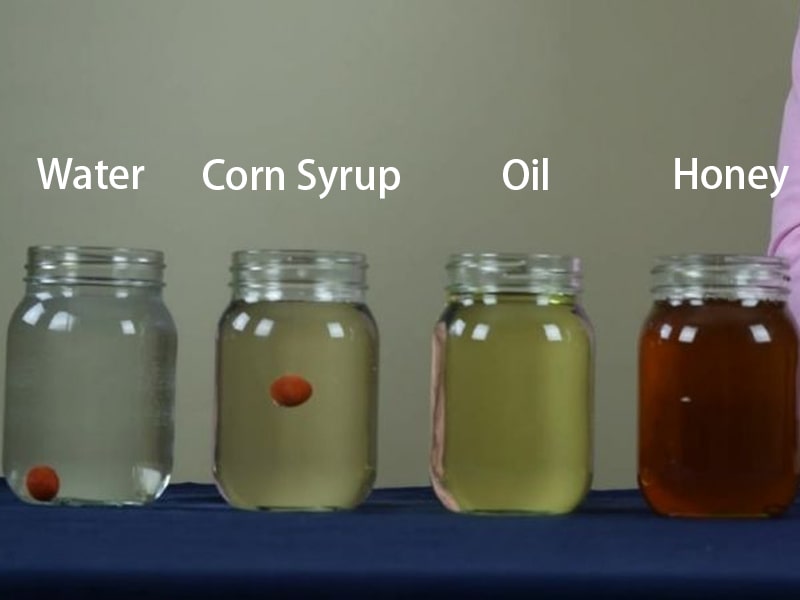
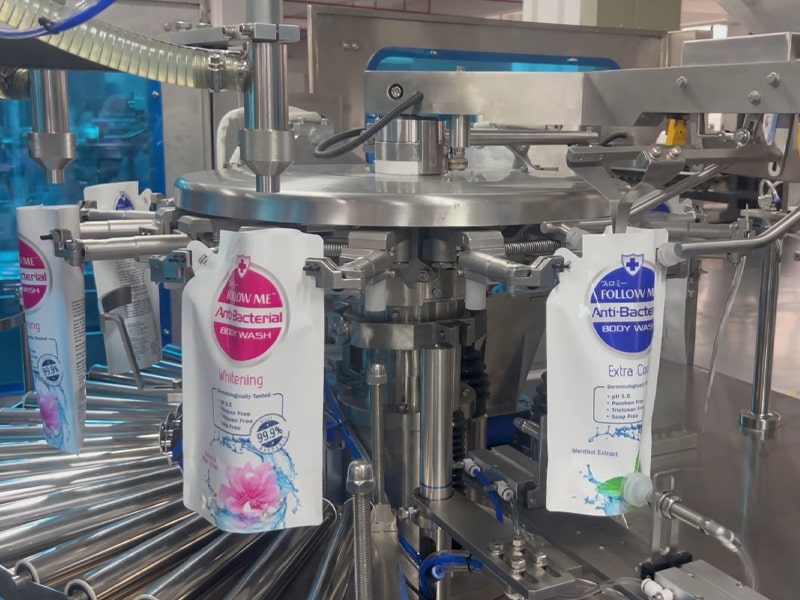


Comments